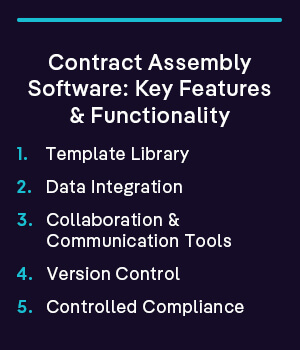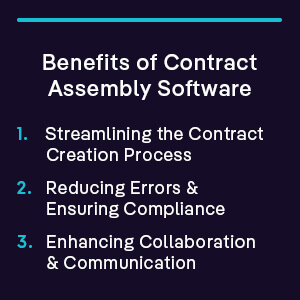No matter whether you’re at a multi-national organization or growing small business, you are likely burdened with countless contracts scattered throughout your offices and computers. Outdated manual contracting processes, disorganization, and disparate systems waste valuable time and cause costly errors that affect a company’s bottom line. Contract lifecycle management (CLM) organizes the meticulous and complex contractual process to draft agreements efficiently, locate them quickly, and assess their risks and obligations accurately.

Effective CLM tools enable your legal department to focus on higher-value initiatives by automating, and even accelerating, their contracting processes. It allows users to improve a business’ operational performance by reducing manual work, costs, and risks while ensuring compliance and security.
Understanding Contract Assembly Software
What is Contract Assembly Software?
Contract assembly software is a key piece of contract lifecycle management technology that automates and streamlines the contract creation process. It creates customized contracts by pulling contract data into pre-made templates, saving time, and ensuring contractual accuracy and precision by diminishing human error.
Key Features and Functionality
Template Library

Contract assembly technology uses a centralized template library that houses pre-approved, customizable templates for various contract types (vendor, Non-disclosure Agreements, employment, sales, etc.). Managing all contract templates from a single source ensures that information is always consistent and up-to-date on the latest standards and regulations. Legal and non-legal professionals can enable self-service contracting by pulling this data into agreements quickly and easily while maintaining a transparent audit trail.
Data Integration
Ensuring that your contracts include the correct, compliant language is critical to mitigate risk and increase productivity. Document assembly software helps pull in precisely approved clauses and information from all available sources. This reduces significant time and effort associated with manual input and copy/paste efforts. Seamless data integration enables faster agreement creation and ensures up-to-date and accurate information each time.
Collaboration and Communication Tools
All internal and external parties must be able to collaborate to manage agreements and execute simple or complex contracts with total confidence. Real-time communication, including feedback and suggested changes, cuts delays from back-and-forth exchanges and encourages teams to work together to speed up the approval process and finalize agreements with ease.
Version Control
Maintaining version control over a contract improves document management and guarantees everyone is working from the latest document. Contract creation tools store all edits, revisions, and comments so that you can see the entire evolution of the contract, including when changes happened and who made them.
Controlled Compliance
Contract preparation software helps minimize both internal and external risk by ensuring each contract adheres to the compliance standards at every level – company, regulatory, etc. – by suggesting preferred, pre-approved fallback contractual language.
Benefits of Contract Assembly Software

Streamlining the Contract Creation Process
Manual contract creation can be slow, frustrating, and tedious. EY Law and the Harvard Law School Center on the Legal Profession cite that 50% of organizations claim that inefficiencies in contracting processes have cost them business. Locating information, ensuring compliance, managing different versions, seeking feedback, and so many more administrative steps often include delays, bottlenecks and even losing documents entirely.
Contract creation software eliminates burdensome paperwork and disparate systems by automating a critical step within the entire contract lifecycle process. Both legal departments and business users are empowered to draft legally binding documents with ease, seamlessly share it across departments, and then seek contract approval. Non-legal professionals can leverage self-service contracting without relying on an attorney’s involvement, which can often cause setbacks due to unavailability or an overwhelming workload. Shortened contract cycle times and increased productivity afford lawyers more time to focus on strategic initiatives, minimize burnout, and reduce legal operating expenses.
Reducing Errors and Ensuring Compliance
Even the most tenured contract experts are bound to make unintentional mistakes. When it comes to contracts, any mistake can be costly. Using outdated language, forgetting key compliance clauses, quoting incorrect pricing, and excluding critical stakeholders are detrimental throughout the entire contract lifecycle. And all these inadvertent errors can be avoided by using contract assembly software. In fact, according to Gartner Reports, contract lifecycle management software can improve compliance by 55%.
The best contract management software offers a proven approach to quality assurance and compliance checks by allowing legal operations and business teams to create a contract with total control over the process, from the initial draft to a signed agreement. Relevant documents are collected instantly in a pre-specified workflow, which eliminates potential risk AND saves valuable time. Because contract management software includes version control, each stakeholder is confident that they have total access to the full transparency of the contract’s lifecycle. And the legal teams on both sides of the deal know that proper safeguards are in place to keep the contracting process smooth and compliant.
Enhancing Collaboration and Communication
Executing a contract on time and accurately are obviously two primary goals in business. Yet when communication between parties is hindered, both goals become difficult to achieve and customer satisfaction is sacrificed. Contract management solutions offer real-time collaboration at any time, including editing and commenting. Not only does this speed up the contracting process, but it also streamlines decision-making and encourages better relationships between all involved parties. Contracts are delivered faster and confidently amongst all teams.
Clear communication is necessary to ensure that all stakeholders fully understand the terms and conditions, mandates, and expectations. Contract management tools help avoid misunderstandings and potential disputes by keeping everyone on the same page and holding people accountable for their roles and responsibilities.
Implementation Best Practices
Assessing Your Organizational Needs
Before diving headfirst into implementing contract assembly software, it’s crucial to thoroughly assess your organization’s needs. This involves conducting a comprehensive evaluation of your current contract management processes, identifying pain points, and determining specific objectives you aim to achieve with the software. Consider factors such as the volume of contracts, the complexity of your agreements, regulatory requirements, collaboration needs, and integration capabilities with existing systems.
Engage stakeholders from various departments across your organization to gather insights and ensure that the selected software aligns with their requirements. By understanding the unique challenges and priorities of each team, you can tailor the implementation process to address their needs effectively.
Selecting the Right Software Solution
As with any technology, there are many contract management systems and contract management vendors in the marketplace to consider. So how do you choose the best solution? After identifying the business goals and needs, begin by considering two key factors:
System Integration
One of the most important considerations when researching different contract management software is how it will integrate with your existing systems. Building a smart contract relies on several different platforms, such as CRM, ERP, and more. A seamless flow of data between these tools will ensure the contracting process is seamless, reliable, and efficient. It also ensures your users feel more comfortable and confident using the system.
Scalable for the Organization
If your goal is to grow the business, your technology systems need to have the capability to grow too. Scaling with the company means it can easily adapt to changing demands within and outside of the organization. The ability to customize new templates, workflows, and the number of users, all while meeting regulatory and internal compliance regulations is critical.
Training and Onboarding Strategies
Resistance to change can pose significant challenges when introducing new software. A poorly designed interface or complex processes will discourage teammates from learning and embracing it. Choose an intuitive system that will maximize the program’s value and avoid frustration. Taking time to train staff means they are not working on billable hours or revenue-increasing initiatives, negatively impacting the bottom line. Leverage vendor support with their training efforts – written guides, online tutorials on in-person education – to ease the transition and make adoption faster and more successful. Encourage knowledge experts to share positive examples and results after using the contract management platform.
Future Trends in Contract Assembly Software

Technology will be forever evolving and that doesn’t exclude the contract management landscape. The introduction of digital technologies, enhanced workflow automation, and data-driven analytics is changing how companies handle contractual relationships.
To stay competitive and relevant, we expect leading companies to embrace the following trends that are already taking shape and will gain speed soon:
Artificial Intelligence and Automation
According to a recent Wolters Kluwer report, nearly three in four lawyers (73%) say they plan to utilize generative Artificial Intelligence (AI) in their legal work within the next year. AI is becoming part of everyday tasks – have you met ‘Siri’ or ‘Alexa’?, and will continue to revolutionize contract management as well. Contract experts will leverage AI algorithms to extract data, determine business risks, and guide smarter decision-making at lightning speed. AI helps locate and understand complex contractual language instantly and then formulate an analysis on cue.
Integration with Other Business Systems
Running a successful business involves several key systems, including customer relationship management (CRM), enterprise resource planning (ERP), vendor management, and many more. Ignoring integrations with these robust systems into contract management creates information siloes, a heavier workload, and compliance risks.
Forward-thinking organizations will realize the benefits of a customized, multi-system integration to foster improved communication, build stronger relationships, and create more efficient business processes. The strategic sharing and exchanging of information across an entire organization improves operational effectiveness at every level. Using key integrations with other SaaS solutions helps professionals work more efficiently and allows management to maintain consistent accuracy.
Cloud-based Technology
Contract assembly software will shift towards cloud-based instead of on-premise solutions. This facilitates better accessibility, future scalability, and a more secure environment. Maintaining security with contractual data and client information via encryption protects your data from unwanted access and cyber threats. It is critical to establish and grow strong, confident relationships with existing and potential customers
Why ContractPodAi for Contract Assembly
ContractPodAi offers an end-to-end contract management system with powerful AI to meet and exceed all your contract assembly needs. It offers self-service templates, pre-approved clause libraries, and intuitive workflows to generate standard contracts independently. It enables cross-functional collaboration across the contract lifecycle with collaborative tools for creating, negotiating, executing, and renewing contracts—ensuring smooth stakeholder experience at every step. It automates the contracting process for legal teams and their business users across processes and systems.
Book a demo with ContractPodAi to experience the future of contract management.


